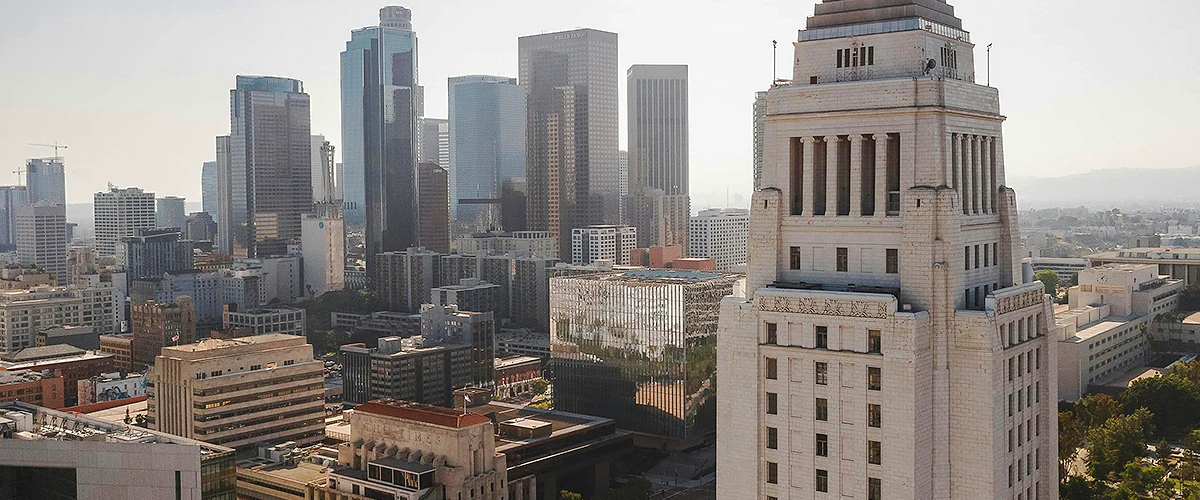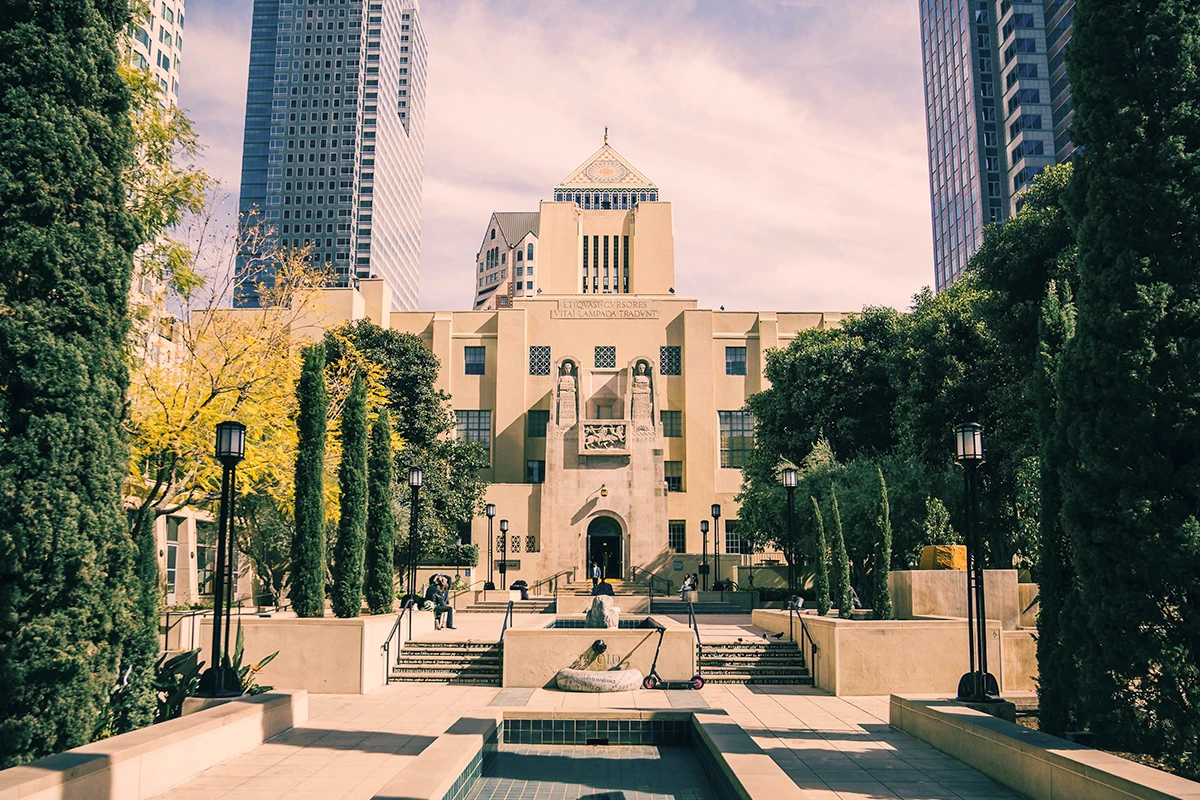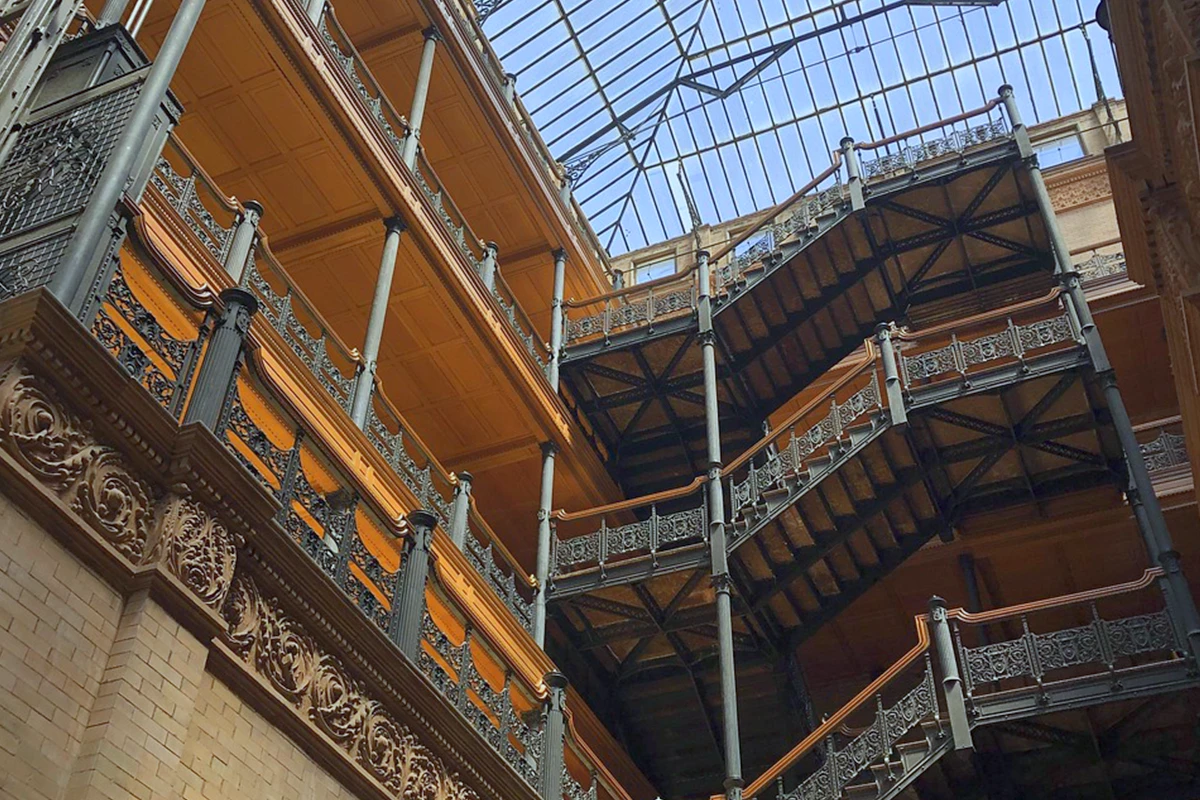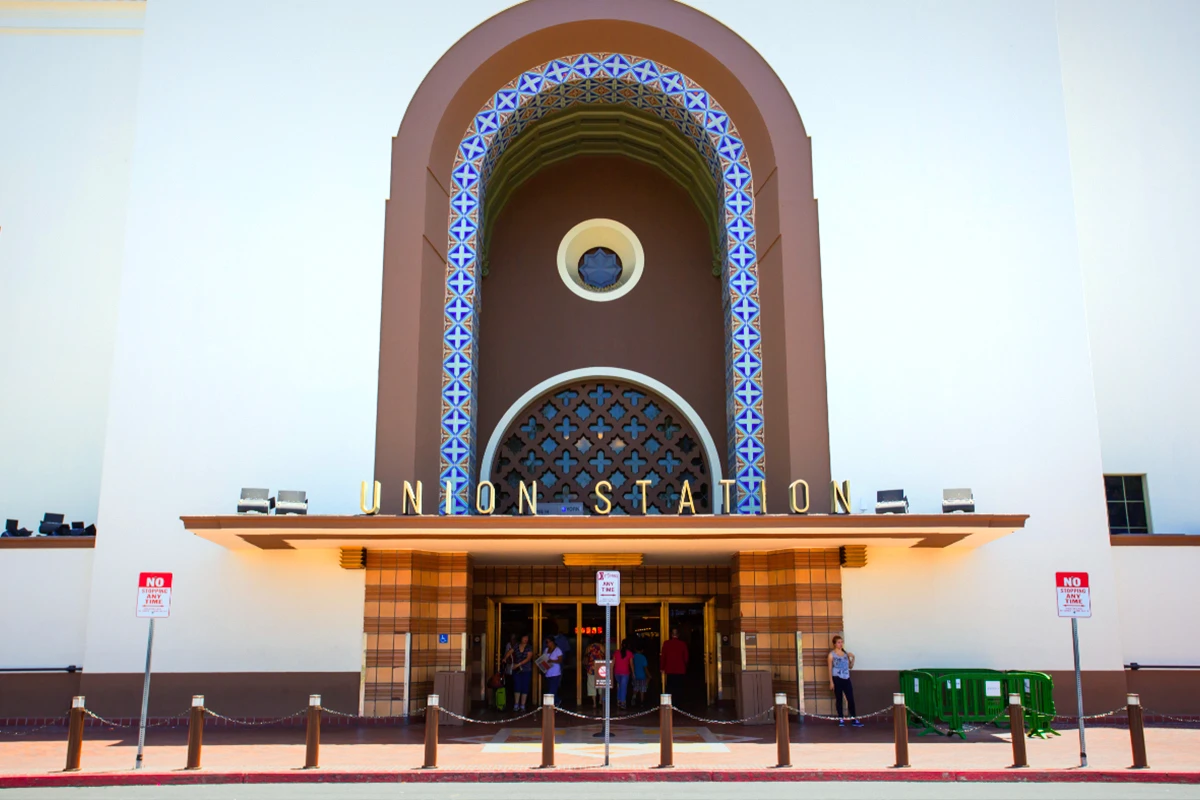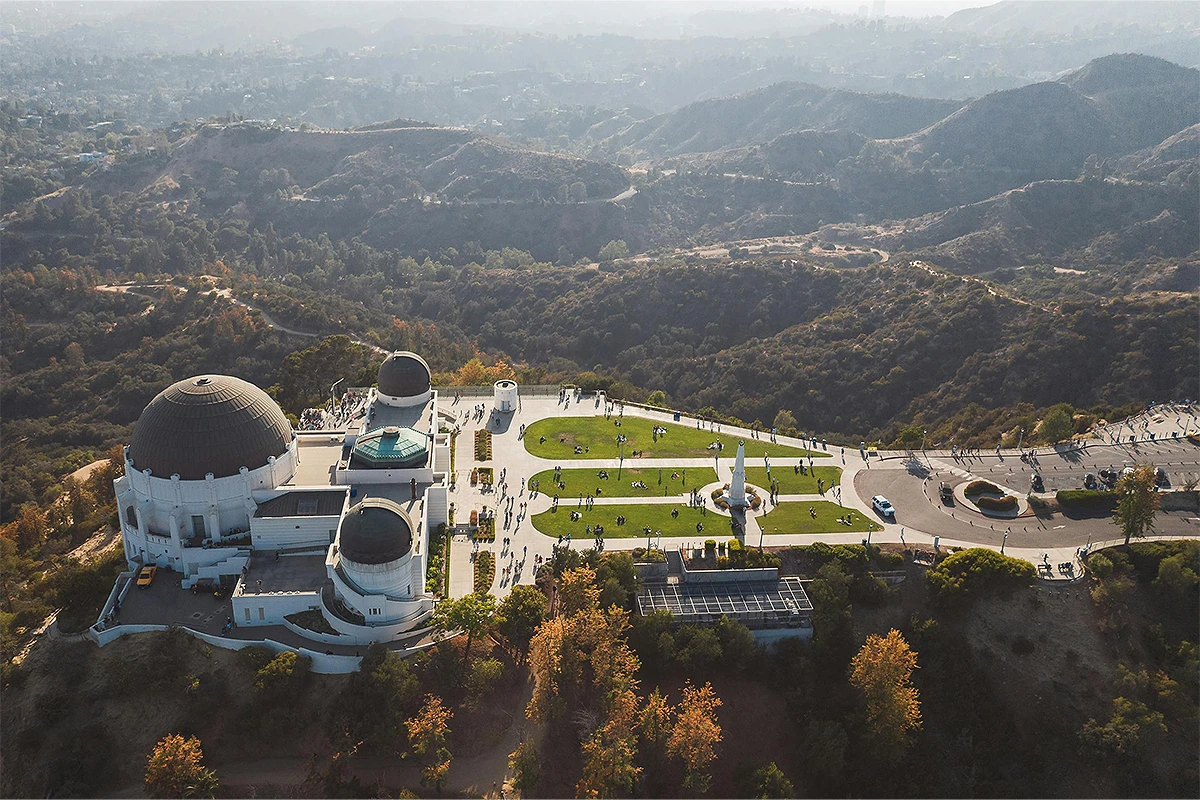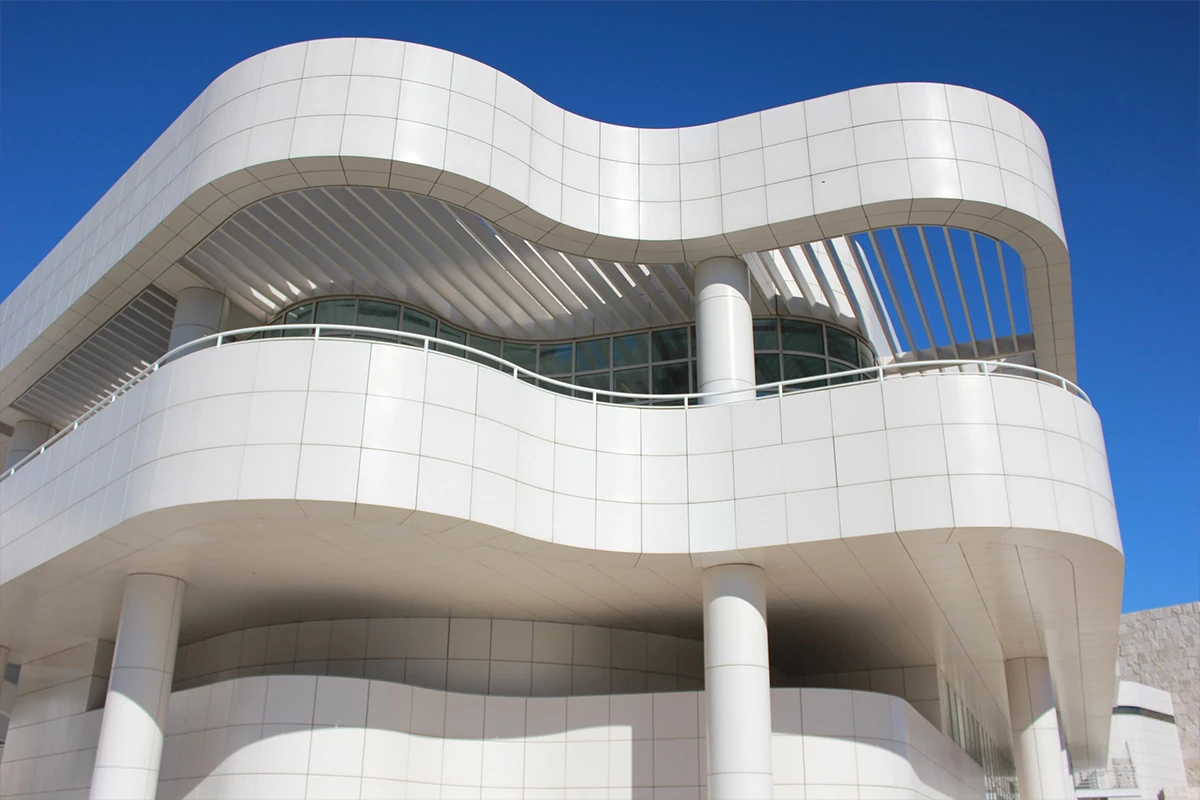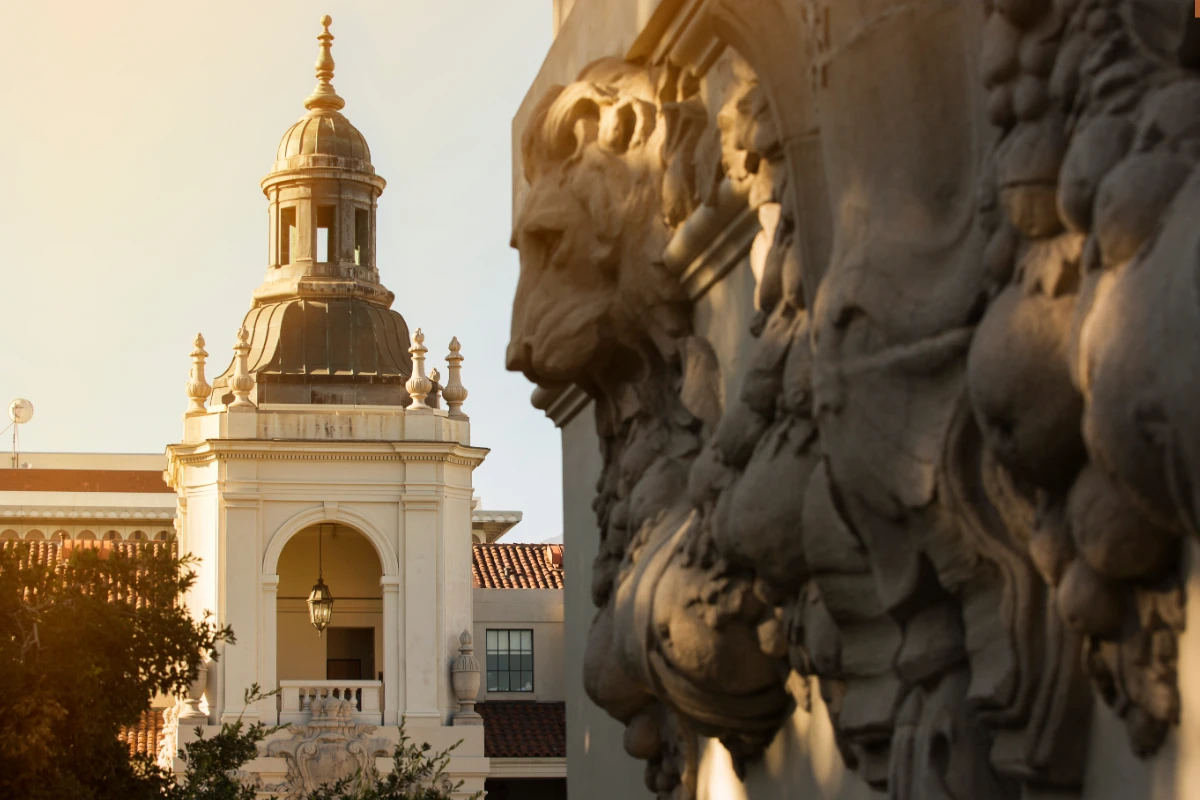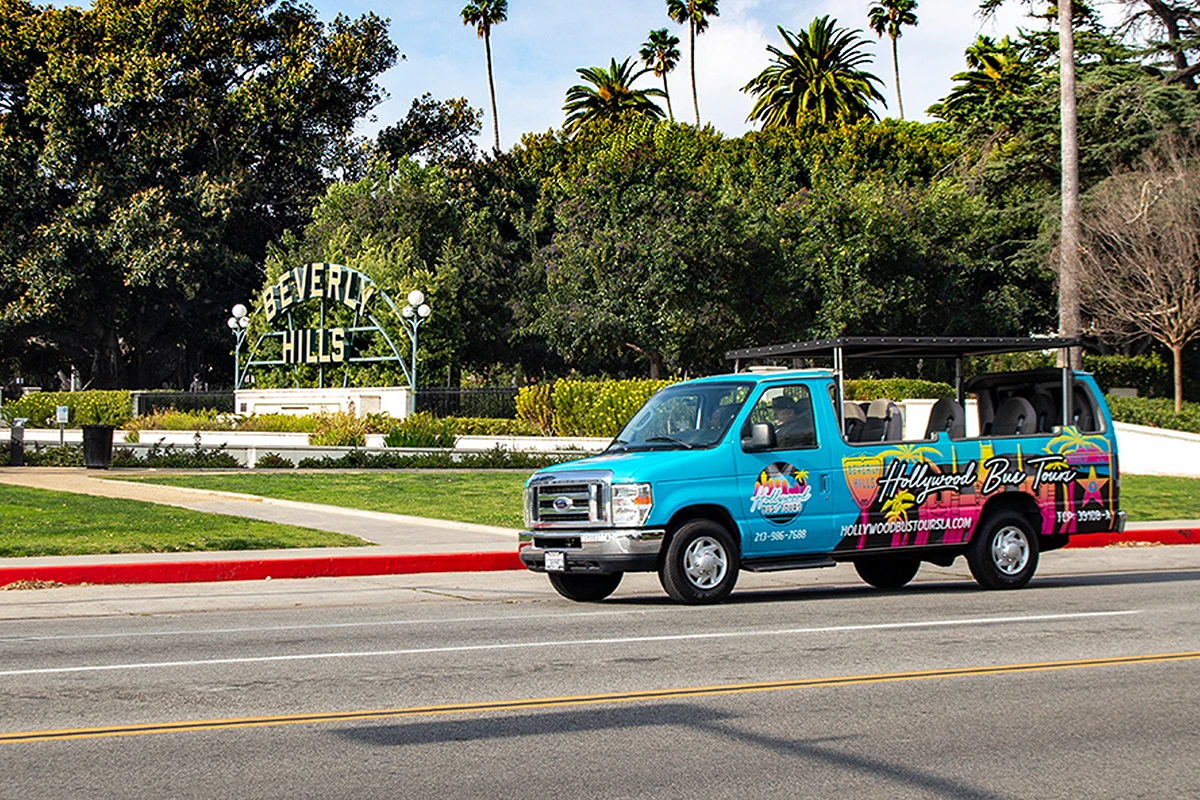Los Angeles tells its story through buildings. From Frank Gehry’s swooping steel curves at Walt Disney Concert Hall to Frank Lloyd Wright’s geometric hollyhock motifs, the city’s architecture spans over a century of bold experimentation and cultural fusion.
This self-guided tour takes you through Downtown LA’s most striking buildings, with optional stops in Hollywood and the Westside. You’ll walk past Art Deco towers that defined 1920s glamour, explore deconstructivist masterpieces that reshaped modern design, and discover how Spanish Colonial Revival blended with Streamline Moderne to create LA’s unique architectural identity.
Ready to experience LA’s architectural highlights with expert commentary? Our A Taste of LA Tour includes stops at Griffith Observatory and Grand Central Market, combining the city’s best architecture with Hollywood landmarks, local food scenes, and insider stories you won’t find in guidebooks.
Whether you’re an architecture enthusiast or simply curious about the buildings that shaped Los Angeles, this tour reveals the visual DNA of America’s most cinematic city. Most stops are free to explore, many offer interior access, and the entire downtown portion covers less than two miles of walking through the heart of LA’s cultural district.
Start at Walt Disney Concert Hall and prepare to see Los Angeles through the eyes of the visionaries who built it.
Downtown L.A. Walking Route
1. Walt Disney Concert Hall – Frank Gehry’s Deconstructivist Masterpiece
Begin your architectural tour at Frank Gehry’s 2003 masterpiece. The stainless-steel curves create different reflections throughout the day, transforming the building’s appearance with the changing light. Gehry’s deconstructivist approach rejected traditional architectural rules, instead creating flowing forms that seem to dance above Grand Avenue.
Walk through the outdoor garden and climb to the rooftop terrace for free. The lobby spaces showcase Gehry’s attention to interior flow, with curved walls and unexpected angles that mirror the exterior design. This building single-handedly reshaped downtown LA’s architectural identity, proving that bold contemporary design could thrive alongside the city’s historic structures.
Pro tip: Visit during golden hour when the steel surfaces create warm reflections across the neighbourhood.
2. The Broad Museum – Contemporary “Veil and Vault” Innovation
Steps away from Disney Hall, The Broad Museum represents the next generation of Los Angeles architecture. Diller Scofidio + Renfro designed this 2015 building around a “veil and vault” concept—the honeycomb-like white facade filters natural light while concealing the storage vault that houses the collection.
Free admission requires advance reservations, but the lobby remains open to visitors. The perforated exterior creates constantly shifting shadow patterns throughout the day, demonstrating how contemporary architects use light as a building material. The contrast between The Broad’s geometric precision and Gehry’s organic curves illustrates two distinct approaches to modern design.
3. Los Angeles Central Library – Egyptian Revival Meets Mediterranean Style
Bertram Goodhue’s 1926 library combines Egyptian Revival and Mediterranean Revival styles in ways that shouldn’t work—but absolutely do. The distinctive tiled pyramid tower draws from ancient Egyptian architecture, while the interior rotunda features murals depicting California’s history and mythology.
Enter through the main entrance to experience the full impact of Goodhue’s design. The mosaic work and painted ceilings demonstrate the craftsmanship that defined 1920s public buildings. This library proves that Los Angeles architects have always borrowed from global traditions, creating something uniquely Californian in the process.
Insider tip: The Tom Bradley Wing addition shows how modern architects can respectfully expand historic buildings without compromising the original design.
4. Millennium Biltmore Hotel – Beaux-Arts Grandeur in Downtown LA
The 1923 Millennium Biltmore showcases Schultze & Weaver’s mastery of Beaux-Arts architecture blended with Spanish-Italian Renaissance Revival elements. Step into the lobby to witness gilded ceilings, marble columns, and murals that transported 1920s guests into European luxury.
This hotel hosted the first eight Academy Awards ceremonies, making it a crucial piece of Hollywood’s architectural history. The public spaces remain open to visitors, offering a glimpse into the opulent world that defined Los Angeles during its early boom years. The architectural details—from hand-painted ceilings to imported marble—represent the kind of craftsmanship rarely seen in contemporary construction.
5. Bradbury Building – Victorian Ironwork Meets Romanesque Revival
George Wyman’s 1893 Bradbury Building houses one of Los Angeles’s most photographed interiors. The skylit atrium features wrought-iron staircases, open elevators, and soaring brick walls that create dramatic light patterns throughout the day.
While public access is limited to the lobby, the view into the central court reveals the building’s genius. Wyman combined Romanesque Revival exterior with cutting-edge Victorian ironwork technology, creating spaces that feel both industrial and elegant. Film buffs will recognize the interior from Blade Runner, where it served as the backdrop for the movie’s climactic scenes.
It’s no surprise the Bradbury Building also made our Top 40 Things to Do in Hollywood list—it’s one of those rare places where history, design, and pop culture all come together in a single stop.
Photography note: The best light hits the atrium between 10 AM and 2 PM when natural light filters through the glass roof.
6. Grand Central Market & Homer Laughlin Building – Early Commercial Architecture
John B. Parkinson’s 1917 design created one of LA’s first major food halls inside the Homer Laughlin Building. The Beaux-Arts facade conceals spaces that have continuously served the community for over a century, evolving from a traditional market into a modern food destination.
Look for original tilework, decorative moldings, and the way Parkinson designed the interior to maximize natural light and air circulation. The market demonstrates how thoughtful architecture can adapt to changing uses while maintaining its essential character. Grab a snack here—you’ll need energy for the remaining stops.
7. Million Dollar Theatre – Spanish Baroque Meets Early Cinema
Albert C. Martin’s 1918 theatre features one of downtown LA’s most ornate facades. The Churrigueresque detailing—an elaborate Spanish Baroque style—created the perfect entrance for one of America’s first movie palaces. The decorative stonework and theatrical marquee announced that cinema had arrived as a legitimate art form.
Public access varies depending on events, but the exterior alone demonstrates how early 20th-century architects used ornamental styles to elevate entertainment architecture. This building helped establish Broadway as LA’s theatre district, showing how individual structures can transform entire neighbourhoods.
Want to explore the best of LA without mapping it out yourself? Our A Taste of LA Tour brings together city highlights, iconic architecture, and local food stops in one seamless experience—complete with expert commentary along the way.
8. Union Station – Mission Revival Meets Streamline Moderne
The Parkinson firm’s 1939 Union Station represents the pinnacle of LA’s distinctive architectural fusion. Mission Revival elements like tile floors and wood-beamed ceilings combine with Streamline Moderne fixtures and Art Deco geometries, creating spaces that feel uniquely Californian.
The dramatic waiting hall remains open to visitors and continues serving as an active train station. Union Station proves that functional architecture can achieve grandeur without sacrificing efficiency. The integration of Spanish Colonial and Art Deco elements became a template for Los Angeles institutional architecture.
Travel tip: The station connects to Metro lines that can take you to Hollywood and other architectural sites if you prefer public transit to driving.
9. City Hall – Art Deco Symbol of Los Angeles Government
Parkinson, Austin & Martin Sr.’s 1928 City Hall established the visual symbol of Los Angeles government. The white stone tower with geometric ornamentation and tiered form demonstrates how Art Deco architects adapted skyscraper design to California’s climate and culture.
The observation deck opens weekdays, offering panoramic views across downtown and the broader Los Angeles basin. This building appears in countless vintage photographs of the city, making it an essential reference point for understanding how LA’s skyline developed. The architectural details reward close examination—notice how the decorative elements become simpler as the tower rises.
10. Ace Hotel & Theatre – Spanish Gothic Revival Adaptive Reuse
Originally the United Artists Building designed by Walker & Eisen in 1927, this Spanish Gothic Revival structure now houses the Ace Hotel following a thoughtful 2014 renovation. The preserved theatre showcases how adaptive reuse can honor architectural heritage while serving contemporary needs.
The lobby and café remain open to the public, allowing visitors to experience the restored interior spaces. The gothic arches and decorative stonework demonstrate the craftsmanship that defined 1920s commercial architecture. This successful restoration shows how Los Angeles balances preservation with progress.
11. Cathedral of Our Lady of the Angels – Modern Brutalism Meets Adobe Influences
José Rafael Moneo’s 2002 cathedral concludes the downtown portion with contemporary religious architecture. The monumental, minimalist design uses warm concrete and golden light to create spiritual spaces that feel both ancient and modern.
Visitors can access the main sanctuary, chapels, gardens, and underground mausoleum. The harsh geometric shapes soften once you enter, revealing Moneo’s skill at creating intimate spaces within monumental forms. The cathedral demonstrates how contemporary architects can honor religious traditions while embracing modern materials and methods.
Extended Stops – Hollywood and Westside Architecture
12. Griffith Observatory – Art Deco Meets Beaux-Arts
Austin & Ashley’s 1935 observatory combines Art Deco styling with Beaux-Arts planning. The dome-topped building overlooks all of Los Angeles, while interior murals and astronomical decorations celebrate humanity’s relationship with the cosmos.
This iconic stop is included on our A Taste of LA Tour, where you can see how the building’s design reflects 1930s optimism about science and progress while taking in those famous LA views.
Free public access includes interior galleries and rooftop terraces. The building opens Tuesday through Sunday—parking can be challenging, so consider the DASH shuttle from Vermont/Sunset Metro station. The architectural significance lies in how the design balances monumental public architecture with intimate educational spaces.
13. Hollyhock House – Frank Lloyd Wright’s California Debut
Frank Lloyd Wright’s 1921 commission represents his first Los Angeles project and part of a UNESCO World Heritage site. The Mayan Revival and Prairie Style fusion demonstrates how Wright adapted his Midwestern principles to California’s climate and culture.
Tours are available with advance reservations, while the gardens remain open daily for free exploration. The hollyhock motif appears throughout the design, showing Wright’s belief that architecture should integrate natural forms. This house influenced an entire generation of Los Angeles architects who learned to blend geometric precision with organic inspiration.
14. Eames House – Mid-Century Modern Case Study Innovation
Charles and Ray Eames’s 1949 residence represents Case Study House #8, part of an experimental program promoting modern residential design. The steel frame and glass panel construction demonstrated how industrial materials could create warm, livable homes.
The house is viewable from the exterior by appointment only, with limited interior access. The Case Study House Program challenged architects to design affordable, modern homes for post-war America. The Eames House proves that architectural innovation can emerge from practical constraints rather than unlimited budgets.
15. Getty Center – Modernist Architecture Meets Classical Planning
Richard Meier’s 1997 Getty Center demonstrates how contemporary architects can honor classical principles while embracing modern materials. The white travertine buildings, structured gardens, and panoramic views create a modern acropolis above Los Angeles.
Free admission with paid parking makes this accessible to all visitors. The integration of architecture, art, and landscape shows how museum design can enhance rather than compete with collections. Meier’s grid-based planning references classical architecture while the materials and forms remain thoroughly contemporary.
Planning Your Los Angeles Architecture Tour
Transportation: The downtown portion covers less than two miles of walking. Metro stations at Union Station and Pershing Square provide easy access. For Westside stops, driving or rideshare services work best.
Timing: Allow 4-6 hours for the complete downtown walking tour, plus additional time for extended stops. Many buildings offer the best light conditions during mid-morning to early afternoon.
Costs: Most stops are free to explore, though some interior tours require advance reservations or modest fees. Parking fees apply at several locations.
Accessibility: Most buildings offer accessible entrances and facilities, though some historic structures have limitations.
Bonus Architecture Stops by Neighborhood
Beverly Hills Architectural Treasures
Beyond celebrity homes, Beverly Hills showcases exceptional residential architecture spanning Spanish Revival estates to contemporary masterpieces. The area’s tree-lined streets feature works by prominent architects who shaped California’s luxury residential style.
Architectural Heritage of Pasadena
Pasadena offers remarkable Craftsman bungalows, Spanish Colonial Revival buildings, and significant works by architects like Greene & Greene. The downtown area provides walkable access to civic buildings and historic commercial architecture.
Miracle Mile Modernism
The Miracle Mile corridor features outstanding examples of Streamline Moderne and Art Deco commercial architecture from the 1930s and 1940s, representing LA’s car-oriented development patterns.
Frequently Asked Questions
Can I do a Frank Lloyd Wright tour in Los Angeles?
Yes, LA offers several Frank Lloyd Wright sites including Hollyhock House (covered in our tour above), the Ennis House, and Freeman House. A dedicated Frank Lloyd Wright tour requires advance planning since most require reservations and are located across different neighborhoods.
What about a Frank Gehry tour of Los Angeles?
Frank Gehry’s LA works span from his early residential projects in West Hollywood to major institutions like Walt Disney Concert Hall (featured above). A comprehensive Frank Gehry tour would include his Santa Monica residence, the Loyola Law School campus, and various commercial buildings throughout the city.
Is downtown LA good for architecture walking tours?
Downtown L.A provides the best concentration of significant buildings within walking distance. Our guide above covers the essential downtown stops, but the area contains dozens of additional architectural landmarks spanning from 1880s Victorian commercial buildings to contemporary high-rises.
Are there good architecture tours in Beverly Hills?
Beverly Hills architecture tours typically focus on residential estates and commercial buildings along Wilshire Boulevard and Beverly Drive. The area showcases how LA’s luxury residential architecture evolved from Spanish Revival through contemporary styles.
What architectural styles define different LA neighborhoods?
Each LA neighborhood developed distinct architectural character: Hollywood features Spanish Colonial Revival and Art Deco theaters, West Hollywood showcases mid-century modernism, downtown L.A contains the city’s oldest and newest buildings, Pasadena preserves exceptional Craftsman architecture, and the Miracle Mile demonstrates Streamline Moderne commercial design.
Architecture Tours That Bring LA’s Buildings to Life
Los Angeles architecture reflects a city that has always looked forward while honoring its diverse cultural influences. From Art Deco civic buildings to deconstructivist concert halls, these structures tell the story of a place that continuously reinvents itself while maintaining its essential character.
Want a custom LA experience built around your interests? Our Private LA Tours let you create your own itinerary—whether that means focusing on architecture, exploring Hollywood landmarks, or blending the best of Los Angeles into one unforgettable day. You’ll have a dedicated driver-guide, flexible timing, and the comfort of a private vehicle.


